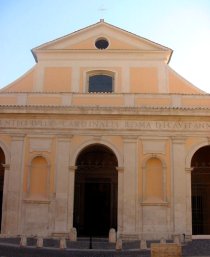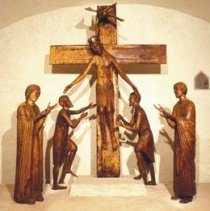Above
the altar in the third side chapel is a priceless 12th century
triptych of the Redeemer: the "Trittico del Salvatore"
![]() .
Painted on wood in Romanesque Byzantine style, and encased
in the 15th century in a gilded silver trame, it shows Christ
preaching between the Holy Virgin and Saint John. The walls
of the chapel are decorated with 17th century frescoes by
Vincenzo Manenti from Orvinio.
.
Painted on wood in Romanesque Byzantine style, and encased
in the 15th century in a gilded silver trame, it shows Christ
preaching between the Holy Virgin and Saint John. The walls
of the chapel are decorated with 17th century frescoes by
Vincenzo Manenti from Orvinio.
The plans for the sacristy were designed by Gianlorenzo Bernini.
The great apse and the vault are painted with frescoes by
Carlo Labruzzi and his school, and a valuable 17th century
organ is located above the presbytery.
The chapel on the right of the presbytery contains a group
of the Deposition of Christ from the Cross ![]() dating from the 13th century.
dating from the 13th century.
The Redeemer and the Cross are surrounded by the Holy Virgin, Saint John the Evangelist, Joseph of Arimathaea, Nicodemus and an angel. This Romanesque masterpiece, carved in poplar wood in a local atelier, shows the beginnings of the gothic style; it was originally cloaked in parchment and coloured cloth, still partially visible. It was restored by the Italian Ministry of Culture between 1986 and 1988.
The newly arranged display of the sculptures stands on a simple
travertine pedestal; thè angel is above the Cross,
crowning the figure of Christ. This arrangement frees the
other figures from any scenographic effect. The rich ornamentation
of the wrought iron gate of the chapel, made in the 17th century,
includes the grill, the instrument of the martyrdom of Saint
Lawrence, the Patron of the Cathedral.
The followìng side chapel contains beautifui and well
preserved frescoes by L. Gimignani (17th century) and P. Locatelli
(18th century). On the altar in the last chapel but one stands
a splendid marble statue of the Immaculate Conception ![]() by the school of Pierre Puget, a pupil of Gianlorenzo Bernini,
sculpted in memory of the 1656 plague, which left Tivoli more
or less unscathed.
by the school of Pierre Puget, a pupil of Gianlorenzo Bernini,
sculpted in memory of the 1656 plague, which left Tivoli more
or less unscathed.
In the last chapel, two paintings hang above the altar. The
oval portrait of the Mater Dolorosa is thought to be the work
of Guido Reni or of his school and dates from the 17th century.
The second picture is a 16th century work: painted on wood
by Alessandro Casolani, it shows the mourning for the death
of Christ. All that remains of the Romanesque medieval Basilica
is the majestic belltower.






